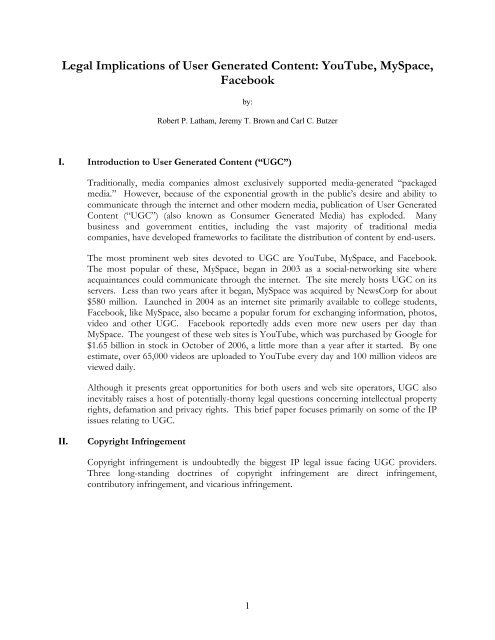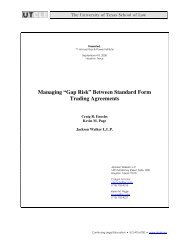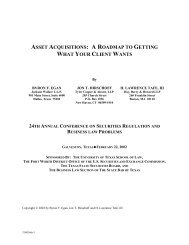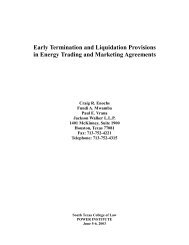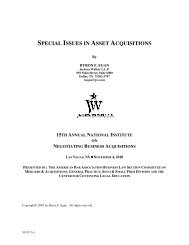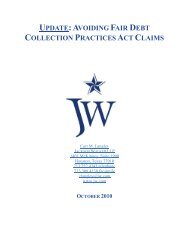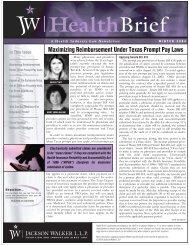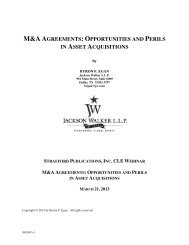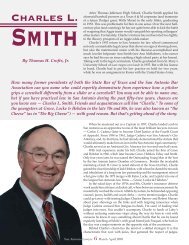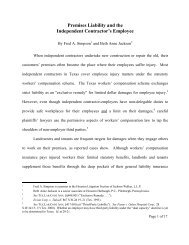Legal Implications of User Generated Content: YouTube, MySpace ...
Legal Implications of User Generated Content: YouTube, MySpace ...
Legal Implications of User Generated Content: YouTube, MySpace ...
Create successful ePaper yourself
Turn your PDF publications into a flip-book with our unique Google optimized e-Paper software.
<strong>Legal</strong> <strong>Implications</strong> <strong>of</strong> <strong>User</strong> <strong>Generated</strong> <strong>Content</strong>: <strong>YouTube</strong>, <strong>MySpace</strong>,Facebookby:Robert P. Latham, Jeremy T. Brown and Carl C. ButzerI. Introduction to <strong>User</strong> <strong>Generated</strong> <strong>Content</strong> (“UGC”)Traditionally, media companies almost exclusively supported media-generated “packagedmedia.” However, because <strong>of</strong> the exponential growth in the public’s desire and ability tocommunicate through the internet and other modern media, publication <strong>of</strong> <strong>User</strong> <strong>Generated</strong><strong>Content</strong> (“UGC”) (also known as Consumer <strong>Generated</strong> Media) has exploded. Manybusiness and government entities, including the vast majority <strong>of</strong> traditional mediacompanies, have developed frameworks to facilitate the distribution <strong>of</strong> content by end-users.The most prominent web sites devoted to UGC are <strong>YouTube</strong>, <strong>MySpace</strong>, and Facebook.The most popular <strong>of</strong> these, <strong>MySpace</strong>, began in 2003 as a social-networking site whereacquaintances could communicate through the internet. The site merely hosts UGC on itsservers. Less than two years after it began, <strong>MySpace</strong> was acquired by NewsCorp for about$580 million. Launched in 2004 as an internet site primarily available to college students,Facebook, like <strong>MySpace</strong>, also became a popular forum for exchanging information, photos,video and other UGC. Facebook reportedly adds even more new users per day than<strong>MySpace</strong>. The youngest <strong>of</strong> these web sites is <strong>YouTube</strong>, which was purchased by Google for$1.65 billion in stock in October <strong>of</strong> 2006, a little more than a year after it started. By oneestimate, over 65,000 videos are uploaded to <strong>YouTube</strong> every day and 100 million videos areviewed daily.Although it presents great opportunities for both users and web site operators, UGC alsoinevitably raises a host <strong>of</strong> potentially-thorny legal questions concerning intellectual propertyrights, defamation and privacy rights. This brief paper focuses primarily on some <strong>of</strong> the IPissues relating to UGC.II.Copyright InfringementCopyright infringement is undoubtedly the biggest IP legal issue facing UGC providers.Three long-standing doctrines <strong>of</strong> copyright infringement are direct infringement,contributory infringement, and vicarious infringement.1
A. Direct InfringementTo prevail under a theory <strong>of</strong> direct copyright infringement, a plaintiff must show that itowns the copyright in the work and that the defendant violated one or more <strong>of</strong> theplaintiff’s exclusive rights under the Copyright Act, 1 namely:1. reproduction <strong>of</strong> the work; 22. preparation <strong>of</strong> derivative works based on the work; 33. distribution <strong>of</strong> copies <strong>of</strong> the work; 44. public performance <strong>of</strong> literary, musical, dramatic, and choreographic works,pantomimes and motion pictures and other audio visual works; 55. public display <strong>of</strong> literary, musical, dramatic, and choreographic works,pantomimes and motion pictures and other audio visual works; 66. public performance <strong>of</strong> sound recordings by means <strong>of</strong> a digitial audiotransmission. 7B. Contributory InfringementMedia companies have long battled over the extent <strong>of</strong> contributory infringementliability, going back to the battle over the use <strong>of</strong> VCRs. In Sony Corp. v. Universal CityStudios, Inc., commonly known as the Betamax case, the Supreme Court held that thesale <strong>of</strong> a product with substantial non-infringing uses does not establish contributoryinfringement even where that product can also be used for infringing uses. 8However, in MGM Studios Inc. v. Grokster, Ltd., the Supreme Court refined Betamax,holding that contributory infringement may be established where a party distributes aproduct capable <strong>of</strong> both infringing and non-infringing uses with the clearly shownobjective <strong>of</strong> promoting copyright infringement. 9Thus, the elements <strong>of</strong> contributory infringement are:1. the party has knowledge <strong>of</strong> the infringing activity, and1 17 U.S.C. § 501(a).2 17 U.S.C. § 106(1).3 17 U.S.C. § 106(2).4 17 U.S.C. § 106(3).5 17 U.S.C. § 106(4).6 17 U.S.C. § 106(5).7 17 U.S.C. § 106(6).8 464 U.S. 417, 442 (1984).9 545 U.S. 913, 941 (2005).2
2. the party induces or materially contributes to the infringing conduct <strong>of</strong> adirect infringer. 10C. Vicarious InfringementVicarious infringement is one <strong>of</strong> the most hotly debated UGC legal issues. A partymay be held vicariously liable for another’s direct infringement if that party:1. has the right and ability to supervise the direct infringer, and2. has a direct financial interest in the infringing activity. 11D. Recently-Filed Copyright Cases1. Viacom v. <strong>YouTube</strong>On March 13, 2007, after licensing negotiations broke down, Viacom filed a$1 billion copyright infringement suit against <strong>YouTube</strong> and Google. 12Viacom alleges that, although “<strong>YouTube</strong>’s website purports to be a forumfor users to share their own original ‘user generated’ video content . . . ,” thesite promotes “rampant infringement” <strong>of</strong> others’ copyrights. Further,Viacom’s Complaint alleges, the widespread availability <strong>of</strong> such infringingcontent “is the cornerstone <strong>of</strong> [<strong>YouTube</strong>’s] business plan.” Viacomadvances claims for direct, contributory, and vicarious copyrightinfringement, as well as “inducement <strong>of</strong> copyright infringement.” Currently,the case is in the discovery phase. It is noteworthy that after the lawsuitcommenced <strong>YouTube</strong> implemented “audio fingerprinting” technology thatallows it to identify audio portions <strong>of</strong> videos that may infringe another’scopyright. <strong>YouTube</strong> is reportedly close to implementing similar technologyfor video content.2. UMG Recordings v. <strong>MySpace</strong>Several months before Viacom initiated its lawsuit, Universal Music GroupRecordings (“UMG”) sued <strong>MySpace</strong> for infringement, advancing similarclaims and requesting damages close to $1 billion. 13 UMG alleges that<strong>MySpace</strong> was guilty <strong>of</strong> copyright infringement by being a “willing partner” inthe unauthorized uploading <strong>of</strong> video and music content owned by UMG. Asa result <strong>of</strong> this conduct, UMG contends, <strong>MySpace</strong> is liable for direct,contributory, vicarious, and inducement copyright infringement as well as10 Id. at 930. Some have commented that, in Grokster, the Supreme Court set forth a new theory <strong>of</strong> secondaryinfringement, “inducement <strong>of</strong> copyright infringement,,” the elements <strong>of</strong> which are (1) an intent to induce infringement,even though no such inducement actually occurred, and (2) direct infringement. See id. at 936-37; 3 Melville B. Nimmer& David Nimmer, NIMMER ON COPYRIGHT § 12.04[A][4][b] (2006).11 Id. at 930.12 Viacom Intl, Inc. v. <strong>YouTube</strong>, Inc., et al., No. 06-02103 (S.D.N.Y.).13 UMG Recordings Inc. v. <strong>MySpace</strong> Inc., No. 06-07361 (C.D. Cal. complaint filed Nov. 17, 2006).3
violations <strong>of</strong> the California Business and Pr<strong>of</strong>essions code. Discovery is alsoongoing in that suit.E. The Digital Millennium Copyright ActThe Digital Millennium Copyright Act (“DMCA”) was enacted in 1998 to “protectthe intellectual property rights <strong>of</strong> creative works available online in ways thatpromote the use <strong>of</strong> the Internet, both by content providers and users.” 14 Title II <strong>of</strong>the DMCA, the Online Copyright Infringement Liability Limitation Act, created anew section, 17 U.S.C. § 512, entitled “Limitation on Liability Relating to MaterialOnline.” This was a compromise between content owners (e.g., Sony, MGM, andUniversal) and website operators who <strong>of</strong>ten were the unlicensed distributors <strong>of</strong> thatcontent. This compromise gave content owners a mechanism to protect theircopyrighted material through detailed “take down” provisions. “At the same time, itprovides greater certainty to service providers concerning their legal exposure forinfringements that may occur in the course <strong>of</strong> their activities.” 15The DMCA Safe HarborsSection 512 creates four new limitations on liability for copyright infringement by anInternet/online service provider based on the following four categories <strong>of</strong> conductby the ISP:1. Transitory digital network communications – § 512(a), which applies totransmission and routing activities.2. System Caching – § 512(b), which applies to temporary intermediate storageduring transmission.3. Information residing on systems at the direction <strong>of</strong> users – § 512(c), whichapplies to user-directed storage <strong>of</strong> material on a system. This is the safeharbor sought by UGC providers.4. Information location tools – § 512(d), which applies to directories, indexes,references, pointers, and hypertext links including search engines.“These safe harbors limit liability but ‘do not affect the question <strong>of</strong> ultimate liabilityunder the various doctrines <strong>of</strong> direct, vicarious, and contributory liability,’ . . . and14 H. Rep. No. 105-551 Pt. II, at 49.15 Id.; S. Rep. No. 105-190, at 65; 144 CONG. REC. 7, 9236 (1998) (“The bill provides ‘safe harbors’ from liability underclearly defined circumstances, which both encourage responsible behavior and protect important intellectual propertyrights.”). The DMCA provides “immunity to service providers from copyright infringement liability for ‘passive,’‘automatic’ actions in which a service provider’s system engages through a technological process initiated by anotherwithout the knowledge <strong>of</strong> the service provider.” Perfect 10, Inc. v. CCBill, LLC, 340 F. Supp. 2d 1077, 1086 (C.D. Cal.2004) (“Perfect 10 I”); Cyrus Sarosh Jan Manekshaw, Liability <strong>of</strong> ISPS: Immunity from Liability Under the Digital MillenniumCopyright Act and the Communications Decency Act, 10 COMPUTER L. REV. & TECH. J. 101, 114 (2005).4
‘nothing in the language <strong>of</strong> § 512 indicates that the limitation on liability describedtherein is exclusive.’” 16To qualify for the safe harbors in the DMCA, one must first qualify as a “serviceprovider.” The definition <strong>of</strong> “service provider” under § 512(k)(1)(B) applies to the §512(b)-(d) safe harbors. 17 Under § 512(k)(1)(B), a “service provider” is “a provider<strong>of</strong> online services or network access, or the operator <strong>of</strong> facilities therefor, andincludes an entity described in [Section 512(k)(1)(A)]”. 18 UGC websites generally fallwithin this definition.Under § 512(i), a “service provider” must meet two overall conditions:1. Termination PolicyThe service provider must adopt and reasonably implement a terminationpolicy for the accounts <strong>of</strong> subscribers who are repeat copyright infringers, 19and it must inform its subscribers and account holders <strong>of</strong> said policy; and2. Accommodation <strong>of</strong> Standard Technical Measuresa. The service provider must accommodate and not interfere with“standard technical measures,” which means “technical measures that areused by copyright owners to identify or protect copyrighted works andi. have been developed pursuant to a broad consensus <strong>of</strong>copyright owners and service providers in an open, fair,voluntary, multi-industry standards process;ii. are available to any person on reasonable andnondiscriminatory terms; andiii.do not impose substantial costs on service providers orsubstantial burdens on their systems or networks.” 20The Ninth Circuit, in Perfect 10 II, suggests that whether a service provider hasinterfered with “standard technical measures” is a question <strong>of</strong> fact. 21 In that case,16 Perfect 10, Inc. v. CCBill, LLC, 488 F.3d 1102, 1108 (9th Cir. 2007) (“Perfect 10 II”) (citations omitted).17 17 U.S.C. § 512(k)(1)(B).18 Pursuant to Section 512(k)(1)(A), the term “service provider” as used in subsection Section 512(a) “means an entity<strong>of</strong>fering the transmission, routing, or providing <strong>of</strong> connections for digital online communications, between or amongpoints specified by a user, <strong>of</strong> material <strong>of</strong> the user’s choosing, without modification to the content <strong>of</strong> the material as sentor received.”19 The Ninth Circuit has held that “a service provider ‘implements’ a policy if it has a working notification system, aprocedure for dealing with DMCA-compliant notifications, and if it does not actively prevent copyright owners fromcollecting information needed to issue such notifications.” Perfect 10 II, 488 F.3d at 1109 (“[A]n implementation isreasonable if, under ‘appropriate circumstances,’ the service provider terminates users who repeatedly or blatantlyinfringe copyright.”).20 17 U.S.C. § 512(i)(2).5
Perfect 10, Inc. argued that the defendant “did not qualify for any safe harborbecause it interfered with ‘standard technical measures’ by blocking Perfect 10’saccess to [defendant] affiliated websites in order to prevent Perfect 10 fromdiscovering whether those websites infringed Perfect 10 copyrights.” 22 The NinthCircuit remanded the case to the district court because it was unable to determine onthe record “whether accessing websites is a standard technical measure, which was‘developed pursuant to a broad consensus <strong>of</strong> copyright owners and service providersin an open, fair, voluntary, multi-industry standards process.’” 23 As one commentatorwrites, “these ‘standard technical measures’ are notoriously difficult to define in thewake <strong>of</strong> changing norms <strong>of</strong> technology and surveillance. The more consumersurveillance technologies alter the fabric <strong>of</strong> cyberspace, and expand to unmask andrecord the activities and identities <strong>of</strong> Internet subscribers, the more difficult itbecomes to define and construct standard technical measures . . . ” 24In Viacom v. <strong>YouTube</strong>, Viacom asserts that <strong>YouTube</strong> failed to accommodate standardtechnical measures by implementing features that prevent copyright owners fromfinding infringing videos on the <strong>YouTube</strong> website. Viacom points out that <strong>YouTube</strong>allows its users to make hidden videos available to others through features like the“embed,” “share,” and “friends” functions.The UGC Service Provider Safe Harbor – § 512(c)UGC service providers typically invoke the protections <strong>of</strong> § 512(c). This subsectionaffords safe harbor from liability for copyright infringement “by reason <strong>of</strong> thestorage at the direction <strong>of</strong> a user <strong>of</strong> material that resides on a system or networkcontrolled or operated by or for the service provider.” To qualify for protectionunder § 512(c), a UGC provider must, in addition to satisfying the requirementsdiscussed above, meet the eligibility requirements specified in § 512(c). The serviceprovider:1. must not have “actual knowledge” <strong>of</strong> infringing activity;2. in the absence <strong>of</strong> “actual knowledge”, is not aware <strong>of</strong> facts or circumstancesfrom which infringing activity is apparent;3. upon obtaining actual knowledge or awareness, acts expeditiously to removeor disable access to the infringing material;4. does not receive a “financial benefit directly attributable to the infringingactivity”, where the service provider has the “right and ability to control”such activity;21 Perfect 10 II, 488 F.3d at 1115 (“We are unable to determine on this record whether accessing websites is a standardtechnical measure, which was ‘developed pursuant to a broad consensus <strong>of</strong> copyright owners and service providers in anopen, fair, voluntary, multiindustry standards process’”).22 Id.23 Id. (citation omitted).24 Sonia K. Katyal, Privacy vs. Piracy, 7 Yale J. L. & Tech. 222 (2005).6
5. upon proper notification <strong>of</strong> claimed infringement, responds expeditiously toremove or disable access to infringing materials;6. has designated an agent to receive DMCA notices and has provided requisitecontact information on its website and to the Copyright Office.Actual and Apparent Knowledge. The DMCA generally does not require affirmativemonitoring. 25 Although affirmative monitoring may be required if such monitoringbecame a “standard technical measure,” 26 such measures must be “developedpursuant to a broad consensus <strong>of</strong> copyright owners and service providers in an open,fair, voluntary, multi-industry standards process,” and there is little incentive for theservice providers to develop such a broad consensus. Thus, it seems unlikely thatthe need for any affirmative monitoring will be necessary by UGC serviceproviders. 27 Once the UGC provider becomes aware <strong>of</strong> a “red flag,” 28 it may loseliability protection if it fails to take appropriate action. To have apparent knowledgea service provider must have “turned a blind eye” to red flags <strong>of</strong> obviousinfringement. 29Direct financial benefit. The House Report 30 on the DMCA states that the financialbenefit standard is intended to codify and clarify the direct financial benefit element<strong>of</strong> vicarious liability as it has been interpreted in cases such as Marobie-FL, Inc. v.National Association <strong>of</strong> Fire Equipment Distributors. 31 So, for example, the reportprovides that receiving a one-time set-up fee and flat periodic payments for servicefrom a person engaging in infringing activities would not constitute receiving a“financial benefit directly attributable to the infringing activity.” Very importantly,however, the report states that a direct financial benefit would exist if one received25 “As stated in subsection (c)(1), a service provider need not monitor its service or affirmatively seek facts indicatinginfringing activity (except to the extent consistent with a standard technical measure complying with new subsection (h),in order to claim this limitation on liability (or, indeed any other limitation provided by the legislation).” H. Rep. No.105-551 Pt. II, at 53; see H. Rep. 105-551 Pt. I, at 26 (“Once one becomes aware <strong>of</strong> such information, however, one mayhave an obligation to check further”).26 Id.27 3 Melville B. Nimmer & David Nimmer, NIMMER ON COPYRIGHT § 12B.0[B][3] (2006).28 The legislative history provides some guidance as to what constitutes a “red flag”:The “red flag” test has both a subjective and an objective element. In determining whether theservice provider was aware <strong>of</strong> a “red flag,” the subjective awareness <strong>of</strong> the service provider <strong>of</strong> thefacts or circumstances in question must be determined. However, in deciding whether those facts orcircumstances constitute a “red flag” – in other words, whether infringing activity would have beenapparent to a reasonable person operating under the same or similar circumstances – an objectivestandard should be used.H. Rep. No. 105-551, Pt. II, at 53; see also S. Rep. No. 105-190, at 44.29 See Corbis Corp. v. Amazon.com, Inc., 351 F. Supp. 2d 1090, 1108 (W.D. Wa. 2004); Perfect 10 II, 488 F.3d at 1114-15(“[I]n order for a website to qualify as a ‘red flag’ <strong>of</strong> infringement, it would need to be apparent that the websiteinstructed or enabled users to infringe another’s copyright”; the Ninth Circuit remanded on the issues <strong>of</strong> whether thirdpartynotices made defendant aware that it provided services to repeat infringers, and if so, whether they respondedappropriately).30 H.R. Rep. 105-551(I).31 983 F.Supp. 1167, 1179 (N.D. Ill. 1997) (no direct financial benefit where defendant only received a one-time set upfee and recurring flat rate).7
such fees where the value <strong>of</strong> the service lies in providing access to infringingmaterial. So as one court put it, “the central question <strong>of</strong> the ‘direct financial benefit’inquiry . . . is whether the infringing activity constitutes a draw for subscribers, notjust an added benefit.” 32 Viacom argues in its complaint that this is exactly what<strong>YouTube</strong> does: that <strong>YouTube</strong> facilitates access to a large amount <strong>of</strong> infringingmaterial for free. Viacom argues that, in turn, this increases the site traffic for<strong>YouTube</strong>, which sells advertisements based on this increase in site traffic.Right to Control. This term was intended to codify the second element <strong>of</strong> commonlawvicarious liability. 33 Courts have liberalized this requirement somewhat andrequired more than just the “mere ability to block access.” 34Expeditious Removal. Current case law does not provide clear guidance as to whatwill satisfy this element. It is important to note, however, that Congress intended forthe determination <strong>of</strong> an “expeditious” removal or disabling <strong>of</strong> access to infringingmaterial on a case-by-case basis: “Because the factual circumstances and technicalparameters may vary from case to case, it is not possible to identify a uniform timelimit for expeditious action.” 35Section 512(c) NotificationsAs discussed above, one <strong>of</strong> the specific § 512(c) eligibility requirements is that theservice provider must respond expeditiously to remove or disable access to infringingmaterials upon proper notification. If the notification is not proper, the serviceprovider will not lose safe harbor protection for failing to respond to the impropernotice. 36Under the DMCA, in order to be proper a notification must:1. be a written communication;2. be provided to the designated agent <strong>of</strong> the service provider; and3. include substantially the following:32 See Ellison v. Robertson, 357 F.3d 1072, 1078-79 (9th Cir. 2004) (“Financial benefit exists where the availability <strong>of</strong>infringing material ‘acts as a ‘draw’ for customers”; and the draw need not be “substantial.”) (citation omitted); Perfect 10II, 488 F.3d at 1117 (The allegation that the defendant “‘hosts’ websites for a fee” is “insufficient to show that theinfringing activity was ‘a draw’ as required by Ellison.”)..33 Perfect 10 II, 488 F.3d at 1117 (“[W]e hold that ‘direct financial benefit’ should be interpreted consistent with thesimilarly-worded common law standard for vicarious copyright liability.); Ellison v. Robertson, 357 F.3d at 1078 (avicariously liable copyright infringer “derive[s] a direct financial benefit from the infringement and ha[s] the right andability to supervise the infringing activity”).34 See, e.g., Hendrickson v. eBay, 165 F.Supp. 2d 1082, 1093 (C.D. Cal 2001) (ability to remove infringing material did notsatisfy right and ability to control standard); Corbis Corp. v. Amazon.com, Inc., 351 F.Supp. 2d 1090, 1110 (W.D. Wa. 2004)(“Merely because Amazon could identify the zShops defendants and terminate their accounts does not mean theyexercised the type <strong>of</strong> right and ability to control that would disqualify them from § 512(c) safe harbor”);35 H. Rep. 105-551 Pt. II, at 53-54.36 Perfect 10 II, 488 F.3d at 1113 (“Since Perfect 10 did not provide effective notice, knowledge <strong>of</strong> infringement may notbe imputed to CCBill or CWIE based on Perfect 10’s communications.”).8
a. physical or electronic signature <strong>of</strong> person authorized to act on behalf<strong>of</strong> the copyright owner;b. identification <strong>of</strong> the copyrighted work claimed to have been infringedor, if multiple copyrighted works are on a single online site, arepresentative list <strong>of</strong> such works;c. identification <strong>of</strong> the infringing material that is to be removed ordisabled and information reasonably sufficient to permit the serviceprovider to locate the material;d. information sufficient for the service provider to locate the material;e. information sufficient for the service provider to contact thecomplaining party;f. a statement that the complaining party has a good faith belief that use<strong>of</strong> the material is not authorized by the copyright owner, its agent, orthe law; andg. a statement under penalty <strong>of</strong> perjury that notification is accurate andcomplaining party is authorized to act on behalf <strong>of</strong> the copyrightowner.In Perfect 10 II, the Ninth Circuit held that the statute “signals that substantialcompliance means substantial compliance with all <strong>of</strong> § 512(c)(3)’s clauses, not justsome <strong>of</strong> them.” 37 Once proper notification is given, the service provider must moveexpeditiously to remove the infringing material. 38Misrepresentation Under Notice ProcessSection 512(f) makes liable any person who, under § 512, knowingly materiallymisrepresents that material or activity is infringing. This subsection also imposesliability for persons who knowingly materially misrepresent, through use <strong>of</strong> thecounter-notification process, that content was removed or disabled by mistake ormisidentification. Such persons are liable for any resulting damages, including costsand attorneys’ fees incurred by the alleged infringer, copyright owner, or serviceprovider.37 Perfect 10 II, 488 F.3d at 1112 (“Compliance is not ‘substantial’ if the notice provided complies with only some <strong>of</strong> therequirements <strong>of</strong> § 512(c)(3)(A).”); see H. Rep. 105-551 Pt. II, at 56 (A communication substantially complies even if itcontains technical errors such as misspellings or outdated information.).38 Section 512(g) protects service providers from liability for disabling access to or removing material or activity in goodfaith based upon a claim that it is infringing or based upon facts or circumstances from which infringing activity isapparent, regardless <strong>of</strong> whether the material is ultimately determined to be infringing. But again, to be entitled to thisprotection, the service provider must comply with the notification procedures set forth in section 512(g). These aresimilar to the notification requirements <strong>of</strong> section 512(c).9
In July, a <strong>YouTube</strong> user sued Universal Music Publishing Group (“Universal”) formisrepresentation under this section. 39 The plaintiff, Stephanie Lenz, is apr<strong>of</strong>essional editor from Gallitzin, Pennsylvania. Earlier this year, Lenz posted avideo from <strong>YouTube</strong> that showed her child dancing to a slightly audible Prince songplaying in the background. Universal sent <strong>YouTube</strong> a takedown notice and thevideo was removed. Lenz then sent <strong>YouTube</strong> a counter-notice and the video wasultimately reposted to the website. Lenz sued Universal for misrepresentation under§ 512(f). Ms. Lenz claims that use <strong>of</strong> the music was obviously “fair use” andtherefore knowingly misrepresented that the posted content was infringing material.This case may give some guidance as to the meaning <strong>of</strong> “knowingly misrepresents.” 40F. Ownership IssuesDerivative WorksA derivative work is a work that is based on or derived from one or more preexistingworks. Copyright protection covers derivative works if those works include“an original work <strong>of</strong> authorship.” Some examples include: translations, musicalarrangements, and/or dramatizations. This copyright protection is limited, however.The protection only covers the aspects <strong>of</strong> the work that were changed.To create a derivative work, the derivative creator must have permission from theoriginal copyright owner. Therefore, UGC providers should incorporate thispermission into their terms and conditions.Joint OwnershipOftentimes, the UGC material is not the sole product <strong>of</strong> the person posting thecontent. A “joint work” is created when it is prepared by two or more authors withthe knowledge and intention at the time <strong>of</strong> creation that the contributions be mergedinto an “inseparable and independent parts <strong>of</strong> a unitary whole.” 41Joint works create their own unique rights. These include:1. The joint authors are treated as tenants in common.2. Each author has an independent right to use or nonexclusively license use <strong>of</strong>the work.3. The joint author can transfer his ownership to a third party but cannottransfer rights <strong>of</strong> any other joint owner.4. Must account to other joint authors for pr<strong>of</strong>its.39 Lenz v. Universal Music Publishing Group, C 07-03783-MEJ (N.D. Cal. complaint filed July 24, 2007).40 For another case alleging misrepresentation under section 512(f), see Kopp v. Vivendi Universal Games, No. 06-01767(C.D. Cal. complaint filed March 23, 2006).41 17 U.S.C. § 101.10
5. No joint author may make or authorize use <strong>of</strong> the work that would lead todestruction <strong>of</strong> the work.Joint Ownership can be created after creation <strong>of</strong> the work. This can beaccomplished through any <strong>of</strong> the following:1. A transfer via assignment or license.2. Inheritance.3. Becoming subject to community property law.UGC service providers should consider adding to their terms and conditions (orother license procedures) a representation from the person uploading the UGC thathe or she is the sole owner <strong>of</strong> all <strong>of</strong> the IP rights in such content.Below is one example, from <strong>MySpace</strong>’s terms and conditions, that addresses jointownership issues:You represent and warrant that: (i) you own the <strong>Content</strong> posted byyou on or through the <strong>MySpace</strong> Services or otherwise have the rightto grant the license set forth in this section, and (ii) the posting <strong>of</strong>your <strong>Content</strong> on or through the <strong>MySpace</strong> Services does not violatethe privacy rights, publicity rights, copyrights, contract rights or anyother rights <strong>of</strong> any person. You agree to pay for all royalties, fees,and any other monies owing any person by reason <strong>of</strong> any <strong>Content</strong>posted by you to or through the <strong>MySpace</strong> Services.Transfer <strong>of</strong> a Copyrighted WorkFor a transfer to be effective, the transfer must be in writing and signed by all <strong>of</strong> theowners <strong>of</strong> the copyright interest transferred. Also, to permit further transfer, expresslanguage implying the intent to permit assignment or transfer must be present, i.e.“this agreement shall be binding on heirs, successors, and assigns <strong>of</strong> the parties.” Ifany contrary language exists, any attempted transfer or assignment may be invalid.Accordingly, if a UGC service provider desires to obtain a valid transfer <strong>of</strong> UGC, theprovider must take care to comply with the law applicable to the transfer <strong>of</strong>copyrights and include language allowing further transfer.Nonexclusive LicensesA written nonexclusive license signed by the owner <strong>of</strong> the rights prevails over aconflicting exclusive transfer if taken in good faith before the transfer. Thus, anexclusive transferee takes the transfer subject to any nonexclusive licenses. If a UGCservice provider desires to obtain an exclusive license and complete control over thematerial, it should ensure that the copyright owner(s) have not given anynonexclusive licenses.11
III.Defamation and Other Speaker Related ActionsAlthough most prominent, and possibly most costly, copyright issues are not the only legal issuesrelating to UGC. One need only peruse the latest headlines to hear about the many cases being filedagainst UGC service providers.UGC websites allow users to essentially post whatever content they choose. Sometimes this contentcan be defamatory. The posting <strong>of</strong> allegedly defamatory information has prompted several lawsuitsagainst UGC website providers. For example in Carafano v. Metrosplash, the plaintiff sued a UGCwebsite operator for allegedly false content contained in a dating pr<strong>of</strong>ile that was posted by animposter. 42 Ultimately, the case was dismissed based on immunity provided by the CommunicationsDecency Act.Communications Decency ActThe Communications Decency Act (“CDA”) provides tort immunity to internetservice providers in certain circumstances. Section 230 <strong>of</strong> the CommunicationsDecency Act, provides: “No provider or user <strong>of</strong> an interactive computer service shallbe treated as the publisher or speaker <strong>of</strong> any information provided by anotherinformation content provider.” 43Thus, to qualify for section 230 immunity the defendant must meet the following:1. The defendant must be a provider or user <strong>of</strong> an “interactive computerservice.”2. The cause <strong>of</strong> action must seek to treat the defendant as a “publisher orspeaker” <strong>of</strong> information that is the subject <strong>of</strong> the lawsuit.3. The information must have been provided by another “information contentprovider,” i.e., a third party.Immunity under section 230 has been extended to more than defamation actions,including breach <strong>of</strong> contract, invasion <strong>of</strong> privacy, negligence, negligentmisrepresentation, and more. In fact, a majority <strong>of</strong> federal circuits have interpretedthe CDA to establish broad “federal immunity to any cause <strong>of</strong> action that wouldmake service providers liable for information originating with a third-party user <strong>of</strong>the service.” 44 This does not mean, however, that immunity will attach in allsituations in which a UGC service provider posts UGC content on its website. TheNinth Circuit recently held, in Fair Housing Council <strong>of</strong> San Fernando Valley v.Roommates.com, that an online roommate matching service was not eligible for CDAimmunity for user posted messages in response to pr<strong>of</strong>ile building questions about42 339 F.3d 1119, 1120 (9th Cir. 2003).43 47 U.S.C. § 230(c)(1).44 Perfect 10 II, 488 F.3d at 1118 (citing Almeida v. Amazon.com, Inc., 456 F.3d 1316, 1321 (11th Cir. 2006) (quoting Zeran v.America Online, Inc., 129 F.3d 327, 331 (4th Cir. 1997); see also Carafano v. Metrosplash.com, Inc., 339 F.3d 1119, 1122 (9th Cir.2003) (citing Batzel v. Smith, 333 F.3d 1018, 1026-27 (9th Cir .2003)).12
oommate preferences. 45 This ruling surprised many who thought that the UGCservice provider would fall within the immunity provisions <strong>of</strong> the CDA. The courtruled that in developing the roommate preference questionnaire, the websiteprovider was responsible, in part, for the users’ comments and because <strong>of</strong> this was an“information content provider” and thus not eligible for CDA immunity. 46The CDA will not provide immunity for the actual creator <strong>of</strong> the content – theblogger, the poster, etc.The CDA has no effect on intellectual property law. 47 In other words, the CDAdoes not provide immunity for violations <strong>of</strong> intellectual property law. However,Congress has not provided an express definition <strong>of</strong> “intellectual property law.” ThePerfect 10 II court noted that because <strong>of</strong> the non-uniform nature <strong>of</strong> state intellectualproperty law, interpreting the CDA not to provide immunity to causes <strong>of</strong> actionarising under state intellectual property law would be contrary to the congressionalintent <strong>of</strong> “insulating the development <strong>of</strong> the internet from state law regimes.” 48Therefore, the Ninth Circuit held that, under the CDA, the term “intellectualproperty” means “federal intellectual property.” 49 The law, in this regard, is notsettled and should be researched carefully to see whether CDA immunity applies to aparticular cause <strong>of</strong> action.IV.Privacy and Right <strong>of</strong> PublicityThe posting <strong>of</strong> UGC content can also implicate privacy and publicity rights. For example, ina recent case filed in Dallas, Texas, a teenage girl’s parents sued Virgin Mobile and CreativeCommons, Inc. (a non-pr<strong>of</strong>it company that licenses the sharing <strong>of</strong> flikr.com photos) for libeland invasion <strong>of</strong> privacy relating to the use <strong>of</strong> her picture in an ad campaign. 50 The girl’syouth pastor took a picture <strong>of</strong> the girl at a church event and uploaded it to the flickr.comUGC site. Virgin Mobile allegedly took the photo from flickr.com, and used it in itsadvertising campaign. In the lawsuit, the plaintiff alleges that the unauthorized use <strong>of</strong> thephoto has caused embarrassment and damages to the girl’s reputation.45 489 F.3d 921, 926 (9th Cir. 2007).46 Id.47 47 U.S.C. § 230(e)(2).48 Perfect 10 II, 488 F.3d at 1118.49 See id. at 11.50 Chang v. Virgin Mobile USA, No. DC-07-11386 (Dallas Dist. Ct. originally filed September 19, 2007).13
V. Practical TipsA. For UGC Website Operators1. Do everything possible to ensure that your business falls under the § 512(c)safe harbor provision. This means consultation with an attorney versed inthis area <strong>of</strong> the law. This also means strict and prompt compliance with thenotice and takedown procedures.2. But rather than relying on the safe harbor, a safer approach may be to seekout licenses from content owners. <strong>YouTube</strong>, <strong>MySpace</strong>, and other UGCwebsites have recently begun utilizing this procedure.3. Use click-wrap agreements rather than passive terms and conditions.What is the difference? Click wrap agreements require the user to scrollthrough the terms and conditions and click an “accept” button. Whereaspassive terms and conditions can just be language on the webpage oraccessible via a link but where there is no requirement to click on the link foracceptance. Courts are more likely to enforce a click wrap agreement ratherthan passive terms and conditions. 514. Think carefully about the contents <strong>of</strong> the click wrap agreements so as toensure that all appropriate representations, warranties, and indemnities fromsubmitting users are given. As an example <strong>of</strong> the largest UGC sites approachto terms and conditions, attached are the latest terms and conditions from<strong>YouTube</strong> and <strong>MySpace</strong>.5. In order to make it more likely to fall within the § 512(c) safe harbor by nothaving a “direct financial benefit,” consider removing ads from areas <strong>of</strong> yourwebsite where UGC is posted.a. For example, when a <strong>YouTube</strong> user plays a video, one will notice thatthere are no advertisements that precede the video. Contrast thiswith a non-UGC video on a website such as ESPN.com. This wascertainly a deliberate step taken to try to prevent a court from rulingthat <strong>YouTube</strong> receives a “direct financial benefit” from the infringingmaterial. It remains to be seen whether this will be sufficient orwhether the presence <strong>of</strong> an ad on the same webpage as the UGCvideo will rise to the level <strong>of</strong> “direct financial benefit.”51 1 John W. Hazard, Jr., COPYRIGHT LAW IN BUSINESS AND PRACTICE § 6:30 (rev. ed.) (“With respect to click wraplicenses for downloaded s<strong>of</strong>tware, a technical option that may greatly enhance enforceability <strong>of</strong> a license as to a particularlicensee is if the affirmative action <strong>of</strong> assent (typically clicking on an ‘I agree’ icon) is recorded and attributed toinformation identifying the licensee, e.g., information transmitted pursuant to an online registration process.”).14
6. Take a fresh look at your website to determine whether UGC content ispresent. Many websites that are not your “typical” UGC website still havesome UGC content that could present legal issues for the service provider.B. For <strong>Content</strong> Licensors1. Devote resources to monitoring UGC websites for possible infringement.2. Upon discovery <strong>of</strong> infringing activity, utilize take down provisions. Takecare to comply with these take down provisions as provided for in § 512(c).3. Because issuing a take down notice could result in liability formisrepresentation under § 512(f), carefully consider whether the material isinfringing before issuing a take down notice.4. So that fewer resources are used for monitoring these sites, considerapproaching UGC service providers for licensing and revenue sharingpossibilities.15
17 U.S.C. § 512. Limitations on liability relating to material online 9(a) TRANSITORY DIGITAL NETWORK COMMUNICATIONS. - A service provider shall not beliable for monetary relief, or, except as provided in subsection (j), for injunctive or other equitablerelief, for infringement <strong>of</strong> copyright by reason <strong>of</strong> the provider's transmitting, routing, or providingconnections for, material through a system or network controlled or operated by or for the serviceprovider, or by reason <strong>of</strong> the intermediate and transient storage <strong>of</strong> that material in the course <strong>of</strong>such transmitting, routing, or providing connections, if -(1) the transmission <strong>of</strong> the material was initiated by or at the direction <strong>of</strong> a person otherthan the service provider;(2) the transmission, routing, provision <strong>of</strong> connections, or storage is carried out throughan automatic technical process without selection <strong>of</strong> the material by the service provider;(3) the service provider does not select the recipients <strong>of</strong> the material except as anautomatic response to the request <strong>of</strong> another person;(4) no copy <strong>of</strong> the material made by the service provider in the course <strong>of</strong> suchintermediate or transient storage is maintained on the system or network in a manner ordinarilyaccessible to anyone other than anticipated recipients, and no such copy is maintained on thesystem or network in a manner ordinarily accessible to such anticipated recipients for a longerperiod than is reasonably necessary for the transmission, routing, or provision <strong>of</strong> connections;and(5) the material is transmitted through the system or network without modification <strong>of</strong> itscontent.(b) SYSTEM CACHING. -(1) LIMITATION ON LIABILITY. - A service provider shall not be liable for monetary relief,or, except as provided in subsection (j), for injunctive or other equitable relief, for infringement<strong>of</strong> copyright by reason <strong>of</strong> the intermediate and temporary storage <strong>of</strong> material on a system ornetwork controlled or operated by or for the service provider in a case in which -(A) the material is made available online by a person other than the service provider;(B) the material is transmitted from the person described in subparagraph (A)through the system or network to a person other than the person described insubparagraph (A) at the direction <strong>of</strong> that other person; and(C) the storage is carried out through an automatic technical process for the purpose<strong>of</strong> making the material available to users <strong>of</strong> the system or network who, after the materialis transmitted as described in subparagraph (B), request access to the material from theperson described in subparagraph (A), if the conditions set forth in paragraph (2) are met.(2) CONDITIONS. - The conditions referred to in paragraph (1) are that -16
(A) the material described in paragraph (1) is transmitted to the subsequent usersdescribed in paragraph (1)(C) without modification to its content from the manner inwhich the material was transmitted from the person described in paragraph (1)(A);(B) the service provider described in paragraph (1) complies with rules concerningthe refreshing, reloading, or other updating <strong>of</strong> the material when specified by the personmaking the material available online in accordance with a generally accepted industrystandard data communications protocol for the system or network through which thatperson makes the material available, except that this subparagraph applies only if thoserules are not used by the person described in paragraph (1)(A) to prevent or unreasonablyimpair the intermediate storage to which this subsection applies;(C) the service provider does not interfere with the ability <strong>of</strong> technology associatedwith the material to return to the person described in paragraph (1)(A) the informationthat would have been available to that person if the material had been obtained by thesubsequent users described in paragraph (1)(C) directly from that person, except that thissubparagraph applies only if that technology -(i) does not significantly interfere with the performance <strong>of</strong> the provider's systemor network or with the intermediate storage <strong>of</strong> the material;(ii) is consistent with generally accepted industry standard communicationsprotocols; and(iii) does not extract information from the provider's system or network otherthan the information that would have been available to the person described inparagraph (1)(A) if the subsequent users had gained access to the material directlyfrom that person;(D) if the person described in paragraph (1)(A) has in effect a condition that a personmust meet prior to having access to the material, such as a condition based on payment <strong>of</strong>a fee or provision <strong>of</strong> a password or other information, the service provider permits accessto the stored material in significant part only to users <strong>of</strong> its system or network that havemet those conditions and only in accordance with those conditions; and(E) if the person described in paragraph (1)(A) makes that material available onlinewithout the authorization <strong>of</strong> the copyright owner <strong>of</strong> the material, the service providerresponds expeditiously to remove, or disable access to, the material that is claimed to beinfringing upon notification <strong>of</strong> claimed infringement as described in subsection (c)(3),except that this subparagraph applies only if -(i) the material has previously been removed from the originating site or accessto it has been disabled, or a court has ordered that the material be removed from theoriginating site or that access to the material on the originating site be disabled; and(ii) the party giving the notification includes in the notification a statementconfirming that the material has been removed from the originating site or access to17
it has been disabled or that a court has ordered that the material be removed fromthe originating site or that access to the material on the originating site be disabled.(c) INFORMATION RESIDING ON SYSTEMS OR NETWORKS AT DIRECTION OF USERS. -(1) IN GENERAL. - A service provider shall not be liable for monetary relief, or, except asprovided in subsection (j), for injunctive or other equitable relief, for infringement <strong>of</strong> copyrightby reason <strong>of</strong> the storage at the direction <strong>of</strong> a user <strong>of</strong> material that resides on a system ornetwork controlled or operated by or for the service provider, if the service provider -(A)(i) does not have actual knowledge that the material or an activity using thematerial on the system or network is infringing;(ii) in the absence <strong>of</strong> such actual knowledge, is not aware <strong>of</strong> facts orcircumstances from which infringing activity is apparent; or(iii) upon obtaining such knowledge or awareness, acts expeditiously to remove,or disable access to, the material;(B) does not receive a financial benefit directly attributable to the infringing activity,in a case in which the service provider has the right and ability to control such activity;and(C) upon notification <strong>of</strong> claimed infringement as described in paragraph (3),responds expeditiously to remove, or disable access to, the material that is claimed to beinfringing or to be the subject <strong>of</strong> infringing activity.(2) DESIGNATED AGENT. - The limitations on liability established in this subsection applyto a service provider only if the service provider has designated an agent to receive notifications<strong>of</strong> claimed infringement described in paragraph (3), by making available through its service,including on its website in a location accessible to the public, and by providing to the CopyrightOffice, substantially the following information:(A) the name, address, phone number, and electronic mail address <strong>of</strong> the agent.(B) other contact information which the Register <strong>of</strong> Copyrights may deemappropriate.The Register <strong>of</strong> Copyrights shall maintain a current directory <strong>of</strong> agents available to the public forinspection, including through the Internet, in both electronic and hard copy formats, and mayrequire payment <strong>of</strong> a fee by service providers to cover the costs <strong>of</strong> maintaining the directory.(3) ELEMENTS OF NOTIFICATION. -(A) To be effective under this subsection, a notification <strong>of</strong> claimed infringementmust be a written communication provided to the designated agent <strong>of</strong> a service providerthat includes substantially the following:18
(i) A physical or electronic signature <strong>of</strong> a person authorized to act on behalf <strong>of</strong>the owner <strong>of</strong> an exclusive right that is allegedly infringed.(ii) Identification <strong>of</strong> the copyrighted work claimed to have been infringed, or, ifmultiple copyrighted works at a single online site are covered by a single notification,a representative list <strong>of</strong> such works at that site.(iii) Identification <strong>of</strong> the material that is claimed to be infringing or to be thesubject <strong>of</strong> infringing activity and that is to be removed or access to which is to bedisabled, and information reasonably sufficient to permit the service provider tolocate the material.(iv) Information reasonably sufficient to permit the service provider to contactthe complaining party, such as an address, telephone number, and, if available, anelectronic mail address at which the complaining party may be contacted.(v) A statement that the complaining party has a good faith belief that use <strong>of</strong>the material in the manner complained <strong>of</strong> is not authorized by the copyright owner,its agent, or the law.(vi) A statement that the information in the notification is accurate, and underpenalty <strong>of</strong> perjury, that the complaining party is authorized to act on behalf <strong>of</strong> theowner <strong>of</strong> an exclusive right that is allegedly infringed.(B)(i) Subject to clause (ii), a notification from a copyright owner or from a personauthorized to act on behalf <strong>of</strong> the copyright owner that fails to comply substantially withthe provisions <strong>of</strong> subparagraph (A) shall not be considered under paragraph (1)(A) indetermining whether a service provider has actual knowledge or is aware <strong>of</strong> facts orcircumstances from which infringing activity is apparent.(ii) In a case in which the notification that is provided to the service provider'sdesignated agent fails to comply substantially with all the provisions <strong>of</strong> subparagraph(A) but substantially complies with clauses (ii), (iii), and (iv) <strong>of</strong> subparagraph (A),clause (i) <strong>of</strong> this subparagraph applies only if the service provider promptly attemptsto contact the person making the notification or takes other reasonable steps to assistin the receipt <strong>of</strong> notification that substantially complies with all the provisions <strong>of</strong>subparagraph (A).(d) INFORMATION LOCATION TOOLS. - A service provider shall not be liable for monetaryrelief, or, except as provided in subsection (j), for injunctive or other equitable relief, forinfringement <strong>of</strong> copyright by reason <strong>of</strong> the provider referring or linking users to an online locationcontaining infringing material or infringing activity, by using information location tools, including adirectory, index, reference, pointer, or hypertext link, if the service provider -(1)(A) does not have actual knowledge that the material or activity is infringing;19
(B) in the absence <strong>of</strong> such actual knowledge, is not aware <strong>of</strong> facts or circumstancesfrom which infringing activity is apparent; or(C) upon obtaining such knowledge or awareness, acts expeditiously to remove, ordisable access to, the material;(2) does not receive a financial benefit directly attributable to the infringing activity, in acase in which the service provider has the right and ability to control such activity; and(3) upon notification <strong>of</strong> claimed infringement as described in subsection (c)(3), respondsexpeditiously to remove, or disable access to, the material that is claimed to be infringing or tobe the subject <strong>of</strong> infringing activity, except that, for purposes <strong>of</strong> this paragraph, the informationdescribed in subsection (c)(3)(A)(iii) shall be identification <strong>of</strong> the reference or link, to materialor activity claimed to be infringing, that is to be removed or access to which is to be disabled,and information reasonably sufficient to permit the service provider to locate that reference orlink.(e) LIMITATION ON LIABILITY OF NONPROFIT EDUCATIONAL INSTITUTIONS. - (1) When apublic or other nonpr<strong>of</strong>it institution <strong>of</strong> higher education is a service provider, and when a facultymember or graduate student who is an employee <strong>of</strong> such institution is performing a teaching orresearch function, for the purposes <strong>of</strong> subsections (a) and (b) such faculty member or graduatestudent shall be considered to be a person other than the institution, and for the purposes <strong>of</strong>subsections (c) and (d) such faculty member's or graduate student's knowledge or awareness <strong>of</strong> hisor her infringing activities shall not be attributed to the institution, if -(A) such faculty member's or graduate student's infringing activities do not involvethe provision <strong>of</strong> online access to instructional materials that are or were required orrecommended, within the preceding 3-year period, for a course taught at the institution bysuch faculty member or graduate student;(B) the institution has not, within the preceding 3-year period, received more than 2notifications described in subsection (c)(3) <strong>of</strong> claimed infringement by such facultymember or graduate student, and such notifications <strong>of</strong> claimed infringement were notactionable under subsection (f); and(C) the institution provides to all users <strong>of</strong> its system or network informationalmaterials that accurately describe, and promote compliance with, the laws <strong>of</strong> the UnitedStates relating to copyright.(2) For the purposes <strong>of</strong> this subsection, the limitations on injunctive relief contained insubsections (j)(2) and (j)(3), but not those in (j)(1), shall apply.(f) MISREPRESENTATIONS. - Any person who knowingly materially misrepresents under thissection -(1) that material or activity is infringing, or20
(2) that material or activity was removed or disabled by mistake or misidentification,shall be liable for any damages, including costs and attorneys' fees, incurred by the alleged infringer,by any copyright owner or copyright owner's authorized licensee, or by a service provider, who isinjured by such misrepresentation, as the result <strong>of</strong> the service provider relying upon suchmisrepresentation in removing or disabling access to the material or activity claimed to be infringing,or in replacing the removed material or ceasing to disable access to it.(g) REPLACEMENT OF REMOVED OR DISABLED MATERIAL AND LIMITATION ON OTHERLIABILITY. -(1) NO LIABILITY FOR TAKING DOWN GENERALLY. - Subject to paragraph (2), a serviceprovider shall not be liable to any person for any claim based on the service provider's goodfaith disabling <strong>of</strong> access to, or removal <strong>of</strong>, material or activity claimed to be infringing or basedon facts or circumstances from which infringing activity is apparent, regardless <strong>of</strong> whether thematerial or activity is ultimately determined to be infringing.(2) EXCEPTION. - Paragraph (1) shall not apply with respect to material residing at thedirection <strong>of</strong> a subscriber <strong>of</strong> the service provider on a system or network controlled or operatedby or for the service provider that is removed, or to which access is disabled by the serviceprovider, pursuant to a notice provided under subsection (c)(1)(C), unless the service provider -(A) takes reasonable steps promptly to notify the subscriber that it has removed ordisabled access to the material;(B) upon receipt <strong>of</strong> a counter notification described in paragraph (3), promptlyprovides the person who provided the notification under subsection (c)(1)(C) with a copy<strong>of</strong> the counter notification, and informs that person that it will replace the removedmaterial or cease disabling access to it in 10 business days; and(C) replaces the removed material and ceases disabling access to it not less than 10,nor more than 14, business days following receipt <strong>of</strong> the counter notice, unless itsdesignated agent first receives notice from the person who submitted the notificationunder subsection (c)(1)(C) that such person has filed an action seeking a court order torestrain the subscriber from engaging in infringing activity relating to the material on theservice provider's system or network.(3) CONTENTS OF COUNTER NOTIFICATION. - To be effective under this subsection, acounter notification must be a written communication provided to the service provider'sdesignated agent that includes substantially the following:(A) A physical or electronic signature <strong>of</strong> the subscriber.(B) Identification <strong>of</strong> the material that has been removed or to which access has beendisabled and the location at which the material appeared before it was removed or accessto it was disabled.21
(C) A statement under penalty <strong>of</strong> perjury that the subscriber has a good faith beliefthat the material was removed or disabled as a result <strong>of</strong> mistake or misidentification <strong>of</strong> thematerial to be removed or disabled.(D) The subscriber's name, address, and telephone number, and a statement that thesubscriber consents to the jurisdiction <strong>of</strong> Federal District Court for the judicial district inwhich the address is located, or if the subscriber's address is outside <strong>of</strong> the United States,for any judicial district in which the service provider may be found, and that thesubscriber will accept service <strong>of</strong> process from the person who provided notification undersubsection (c)(1)(C) or an agent <strong>of</strong> such person.(4) LIMITATION ON OTHER LIABILITY. - A service provider's compliance with paragraph(2) shall not subject the service provider to liability for copyright infringement with respect tothe material identified in the notice provided under subsection (c)(1)(C).(h) SUBPOENA TO IDENTIFY INFRINGER. -(1) REQUEST. - A copyright owner or a person authorized to act on the owner's behalfmay request the clerk <strong>of</strong> any United States district court to issue a subpoena to a serviceprovider for identification <strong>of</strong> an alleged infringer in accordance with this subsection.(2) CONTENTS OF REQUEST - The request may be made by filing with the clerk -(A) a copy <strong>of</strong> a notification described in subsection (c)(3)(A);(B) a proposed subpoena; and(C) a sworn declaration to the effect that the purpose for which the subpoena issought is to obtain the identity <strong>of</strong> an alleged infringer and that such information will onlybe used for the purpose <strong>of</strong> protecting rights under this title.(3) CONTENTS OF SUBPOENA. - The subpoena shall authorize and order the serviceprovider receiving the notification and the subpoena to expeditiously disclose to the copyrightowner or person authorized by the copyright owner information sufficient to identify thealleged infringer <strong>of</strong> the material described in the notification to the extent such information isavailable to the service provider.(4) BASIS FOR GRANTING SUBPOENA. - If the notification filed satisfies the provisions <strong>of</strong>subsection (c)(3)(A), the proposed subpoena is in proper form, and the accompanyingdeclaration is properly executed, the clerk shall expeditiously issue and sign the proposedsubpoena and return it to the requester for delivery to the service provider.(5) ACTIONS OF SERVICE PROVIDER RECEIVING SUBPOENA. - Upon receipt <strong>of</strong> the issuedsubpoena, either accompanying or subsequent to the receipt <strong>of</strong> a notification described insubsection (c)(3)(A), the service provider shall expeditiously disclose to the copyright owner orperson authorized by the copyright owner the information required by the subpoena,22
notwithstanding any other provision <strong>of</strong> law and regardless <strong>of</strong> whether the service providerresponds to the notification.(6) RULES APPLICABLE TO SUBPOENA. - Unless otherwise provided by this section or byapplicable rules <strong>of</strong> the court, the procedure for issuance and delivery <strong>of</strong> the subpoena, and theremedies for noncompliance with the subpoena, shall be governed to the greatest extentpracticable by those provisions <strong>of</strong> the Federal Rules <strong>of</strong> Civil Procedure governing the issuance,service, and enforcement <strong>of</strong> a subpoena duces tecum.(i) CONDITIONS FOR ELIGIBILITY. -(1) ACCOMMODATION OF TECHNOLOGY. - The limitations on liability established by thissection shall apply to a service provider only if the service provider -(A) has adopted and reasonably implemented, and informs subscribers and accountholders <strong>of</strong> the service provider's system or network <strong>of</strong>, a policy that provides for thetermination in appropriate circumstances <strong>of</strong> subscribers and account holders <strong>of</strong> theservice provider's system or network who are repeat infringers; and(B) accommodates and does not interfere with standard technical measures.(2) DEFINITION. - As used in this subsection, the term "standard technical measures"means technical measures that are used by copyright owners to identify or protect copyrightedworks and -(A) have been developed pursuant to a broad consensus <strong>of</strong> copyright owners andservice providers in an open, fair, voluntary, multi-industry standards process;(B) are available to any person on reasonable and nondiscriminatory terms; and(C) do not impose substantial costs on service providers or substantial burdens ontheir systems or networks.(j) INJUNCTIONS. - The following rules shall apply in the case <strong>of</strong> any application for aninjunction under section 502 against a service provider that is not subject to monetary remediesunder this section:(1) SCOPE OF RELIEF. - (A) With respect to conduct other than that which qualifies for thelimitation on remedies set forth in subsection (a), the court may grant injunctive relief withrespect to a service provider only in one or more <strong>of</strong> the following forms:(i) An order restraining the service provider from providing access to infringingmaterial or activity residing at a particular online site on the provider's system ornetwork.(ii) An order restraining the service provider from providing access to asubscriber or account holder <strong>of</strong> the service provider's system or network who is23
engaging in infringing activity and is identified in the order, by terminating theaccounts <strong>of</strong> the subscriber or account holder that are specified in the order.(iii) Such other injunctive relief as the court may consider necessary to preventor restrain infringement <strong>of</strong> copyrighted material specified in the order <strong>of</strong> the court ata particular online location, if such relief is the least burdensome to the serviceprovider among the forms <strong>of</strong> relief comparably effective for that purpose.(B) If the service provider qualifies for the limitation on remedies described insubsection (a), the court may only grant injunctive relief in one or both <strong>of</strong> the followingforms:(i) An order restraining the service provider from providing access to asubscriber or account holder <strong>of</strong> the service provider's system or network who isusing the provider's service to engage in infringing activity and is identified in theorder, by terminating the accounts <strong>of</strong> the subscriber or account holder that arespecified in the order.(ii) An order restraining the service provider from providing access, by takingreasonable steps specified in the order to block access, to a specific, identified, onlinelocation outside the United States.(2) CONSIDERATIONS. - The court, in considering the relevant criteria for injunctive reliefunder applicable law, shall consider -(A) whether such an injunction, either alone or in combination with other suchinjunctions issued against the same service provider under this subsection, wouldsignificantly burden either the provider or the operation <strong>of</strong> the provider's system ornetwork;(B) the magnitude <strong>of</strong> the harm likely to be suffered by the copyright owner in thedigital network environment if steps are not taken to prevent or restrain the infringement;(C) whether implementation <strong>of</strong> such an injunction would be technically feasible andeffective, and would not interfere with access to noninfringing material at other onlinelocations; and(D) whether other less burdensome and comparably effective means <strong>of</strong> preventingor restraining access to the infringing material are available.(3) NOTICE AND EX PARTE ORDERS. - Injunctive relief under this subsection shall beavailable only after notice to the service provider and an opportunity for the service provider toappear are provided, except for orders ensuring the preservation <strong>of</strong> evidence or other ordershaving no material adverse effect on the operation <strong>of</strong> the service provider's communicationsnetwork.24
(k) DEFINITIONS. -(1) SERVICE PROVIDER. - (A) As used in subsection (a), the term "service provider" meansan entity <strong>of</strong>fering the transmission, routing, or providing <strong>of</strong> connections for digital onlinecommunications, between or among points specified by a user, <strong>of</strong> material <strong>of</strong> the user'schoosing, without modification to the content <strong>of</strong> the material as sent or received.(B) As used in this section, other than subsection (a), the term "service provider"means a provider <strong>of</strong> online services or network access, or the operator <strong>of</strong> facilitiestherefor, and includes an entity described in subparagraph (A).(2) MONETARY RELIEF. - As used in this section, the term "monetary relief" meansdamages, costs, attorneys' fees, and any other form <strong>of</strong> monetary payment.(l) OTHER DEFENSES NOT AFFECTED. - The failure <strong>of</strong> a service provider's conduct to qualifyfor limitation <strong>of</strong> liability under this section shall not bear adversely upon the consideration <strong>of</strong> adefense by the service provider that the service provider's conduct is not infringing under this titleor any other defense.(m) PROTECTION OF PRIVACY. - Nothing in this section shall be construed to condition theapplicability <strong>of</strong> subsections (a) through (d) on -(1) a service provider monitoring its service or affirmatively seeking facts indicatinginfringing activity, except to the extent consistent with a standard technical measure complyingwith the provisions <strong>of</strong> subsection (i); or(2) a service provider gaining access to, removing, or disabling access to material in casesin which such conduct is prohibited by law.(n) CONSTRUCTION. - Subsections (a), (b), (c), and (d) describe separate and distinct functionsfor purposes <strong>of</strong> applying this section. Whether a service provider qualifies for the limitation onliability in any one <strong>of</strong> those subsections shall be based solely on the criteria in that subsection, andshall not affect a determination <strong>of</strong> whether that service provider qualifies for the limitations onliability under any other such subsection.25
4905031v.338


